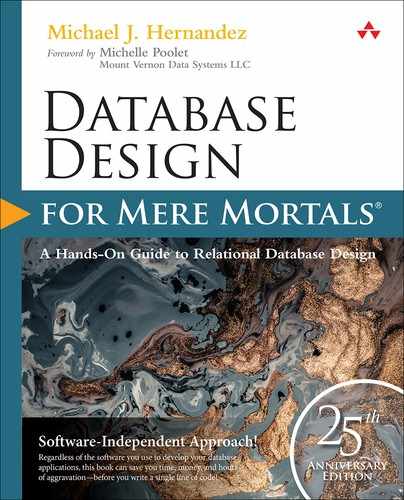Book Description
The #1 Easy, Commonsense Guide to Database DesignNow Updated
Foreword by Michelle Poolet, Mount Vernon Data Systems LLC
Michael J. Hernandezs best-selling Database Design for Mere Mortals has earned worldwide respect as the simplest way to learn relational database design. Now, hes made this hands-on, software independent tutorial even clearer and easier to use.
Step by step, this new 25th Anniversary Edition shows you how to design modern databases that are soundly structured, reliable, and flexible, even in the latest online applications. Hernandez guides you through everything from planning to defining tables, fields, keys, table relationships, business rules, and views. Youll learn practical ways to improve data integrity, how to avoid common mistakes, and when to break the rules. Updated review questions and figures help you learn these techniques more easily and effectively.
Understand database types, models, and design terminology
Perform interviews to efficiently capture requirementseven if everyones working remotely
Set clear design objectives and transform them into effective designs
Analyze a current database so you can identify ways to improve it
Establish table structures and relationships, assign primary keys, set field specifications, and set up views
Ensure the correct level of data integrity for each database
Identify and establish business rules
Preview and prepare for the future of relational databases
Whatever relational database systems you use, Hernandez will help you design databases that are robust and trustworthy. Never designed a database before? Settling for inadequate generic designs? Running existing databases that need improvement? Start here.
Table of Contents
- Cover Page
- About This eBook
- Title Page
- Copyright Page
- Dedication Page
- Contents at a Glance
- Contents
- Figure Credits
- Foreword
- Preface
- Acknowledgments
- About the Author
- Introduction
- Part I: Relational Database Design
- Part II: The Design Process
- 4. Conceptual Overview
- Topics Covered in This Chapter
- The Importance of Completing the Design Process
- Defining a Mission Statement and Mission Objectives
- Analyzing the Current Database
- Creating the Data Structures
- Determining and Establishing Table Relationships
- Determining and Defining Business Rules
- Determining and Defining Views
- Reviewing Data Integrity
- Summary
- Review Questions
- 5. Starting the Process
- 6. Analyzing the Current Database
- 7. Establishing Table Structures
- 8. Keys
- 9. Field Specifications
- 10. Table Relationships
- 11. Business Rules
- 12. Views
- 13. Reviewing Data Integrity
- 4. Conceptual Overview
- Part III: Other Database Design Issues
- Part IV: Appendixes
- Glossary
- References
- Index
